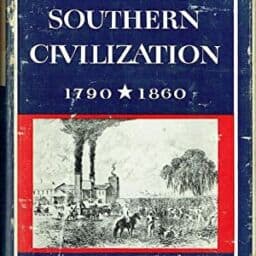Thomas, Emory M. The Confederacy As a Revolutionary Experience:. Englewood Cliffs, N.J.: Prentice-Hall, 1970.
1. Thesis: The Civil War resulted in a radical reshaping and restructuring of Southern society, sparking a revolution that began as an effort to conserve rather than to create. The opposite took place. The war led to the alteration or elimination of accepted Southern social, economic and political principles in favor of a more centralized nation. Indeed, abolition was considered as a last ditch effort to achieve independence!
2. Structure: Thomas examines general histories, books and other works by historians to summarize the Southern way of life as it changed throughout the Civil War. Beginning with secession, he examines the military, political, economic, social and slavery revolutions that take place during the Confederacy.
3. Evidence:
- The Southern Way of Life – racial slavery – could not separate the two notions of slave and race (p.11), “degraded white masters and black slaves both” (p.13), plantation class viewed early as “the ideal class” (p. 15), “moonlight and magnolias” image (p. 20), “involved some combination of state rights, agrarianism, racial slavery, aristocracy, and habits of mind including individualism, personalism toward God and man, provincialism, and romanticism” (p.21), states’ rights way of life – “It was a political habit of mind so long and so articulately used to defend the Southern way of life that finally it became inseparable from that way of life” (p.7), the fire-eaters – Ruffin, Rhett, Yancey, McDuffie, Brooks, Tucker, DeBow, Cheves (p.25-28), fire-eater activities led to “closed Southern mind” (p.38), conserve rather than create – “The Constitution formed by our fathers is that of the Confederate States, in their exposition of it, and in the judicial construction it has received, we have a light which reveals its true meaning” (p.40),
- Military Revolution – C.W. strategy like Revolutionary War strategy (p.45), “offensive defense” – willing to trade space for time (p. 49), “The Confederacy waited on the defense for the opportunity to cripple the invaders” (p.50), Confederate embrace of rebellion – rebels “rose above traditional military wisdom and waged revolution” (p. 52), Mosby, Morgan and Stuart as ‘revolutionaries’ (p.53-54), South could not defend itself without revolutionizing itself (p. 56)
- Political Revolution – shift from fire-eating to moderates push for instant nation (p.39), moderate government leads revolutionary social changes for war needs (p.42), transformed South from states’ rights confederacy to centralized nation for raising armies, controlling citizens (police state), and managing economy (p.58-63), embraced state socialism (p. 65)
- Economic Revolution – agrarianism the antithesis of hated industrialism (p.9), impressments of supplies, printing of money (inflation), graduated income tax, regulatory economic powers of War Dept. – moved faster toward economic nationalism than U.S. (p.68), even took copper from NC mountain stills! (p.70), expanded state/local powers – liquor control, cotton/tobacco limits, food markets – centralization at expense of laissez-faire (p.72), from cotton to cannon (decline of agriculture – rise of industry), lack of industrial base, skills, raw materials & transportation for war industry (p.80)
- Social Revolution – urbanization (N. Orleans, Charleston, Richmond, Mobile, Memphis, Savannah – rapid growth – p.93), mass meetings, labor groups, riots, socialism, welfare advocates, class awareness, plural society, food riots, “rich man’s war, poor man’s fight” (p.103), change of women from object of reverence to active societal participant, bread riots, new pathways to prominence thanks to war (a new Confed. elite) – military service (p. 108-111), a new “sense of corporate identity” (p. 114)
- Revolution of Slavery – the breakdown of the master-slave relationship – paradox (p.121), black labor needs in war/slave revolts/declines in work productivity – “the black wretches trying all they can, it seems to me, to aggravate me, taking no interest, . . . neglecting their duty” (p. 123), black restlessness, Union army proximity led to defections, “at the same time the city fathers were most repressive in terms of race, the city, by the very nature of its economic and social life, made possible a heightened sense of independent black identity” (p. 127), war was God’s way of chastising South for slavery (p. 128), blacks in military – Lee (p. 130), willing to give up slavery for outside help or independence (p. 131)
4. Convincing/Criticisms? Emory Thomas is always a pleasure to read. If, during Reconstruction, the South did return to the very same ways it conducted itself prior to the war, then Thomas is correct that the Confederacy “should stand at the center of Southern historical consciousness” (p.137). Out of secessionist revolution evolved a complete departure (revolution) from the political, social, economic and military structure of the Old South. In order to meet the needs of war, The South did become a completely different animal during the Civil War. In this regard, Thomas delivers a sound argument that the Confederacy’s best efforts to “conserve rather than create” failed during the Civil War.



